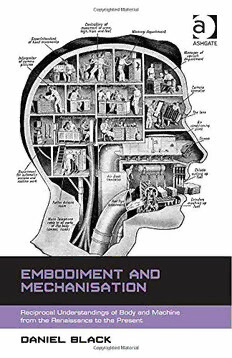
Embodiment and Mechanisation: Reciprocal Understandings of Body and Machine from the Renaissance to the Present PDF
Preview Embodiment and Mechanisation: Reciprocal Understandings of Body and Machine from the Renaissance to the Present
EmbodimEnt and mEchanisation For my family. Embodiment and mechanisation Reciprocal Understandings of body and machine from the Renaissance to the Present Daniel Black Monash University, Australia © Daniel Black 2014 all rights reserved. no part of this publication may be reproduced, stored in a retrieval system or transmitted in any form or by any means, electronic, mechanical, photocopying, recording or otherwise without the prior permission of the publisher. Daniel Black has asserted his right under the copyright, Designs and Patents act, 1988, to be identified as the author of this work. Published by ashgate Publishing limited ashgate Publishing company Wey court east 110 cherry Street Union Road Suite 3-1 Farnham Burlington, VT 05401-3818 Surrey, GU9 7PT USa england www.ashgate.com British Library Cataloguing in Publication Data a catalogue record for this book is available from the British library The Library of Congress has cataloged the printed edition as follows: Black, Daniel (Daniel ariad) embodiment and mechanisation : reciprocal understandings of body and machine from the Renaissance to the present / by Daniel Black. pages cm includes bibliographical references and index. iSBn 978-1-4724-1543-1 (hardback : alk. paper)—iSBn 978-1-4724-1545-5 (ebook)— iSBn 978-1-4724-1544-8 (epub) 1. Human body—Social aspects—History. 2. Human body and technology—History. 3. Human mechanics—History. i. Title. HM636.B526 2014 301—dc23 2013038852 iSBn 9781472415431 (hbk) iSBn 9781472415448 (ebk – PDF) iSBn 9781472415455 (ebk – ePUB) V Contents List of Figures vii Preface ix Introduction 1 1 How to Look at Bodies 13 2 Machina Carnis 41 3 Android Dreams 75 4 Informateriality 105 5 An Aesthetics of the Invisible 147 Conclusion 183 Bibliography 191 Index 205 This page has been left blank intentionally List of Figures 2.1 Rembrandt van Rijn (1606–1669), The Anatomy Lesson of Dr Nicolaes Tulp, 1632. Canvas, 169.5 x 216.5 cm, inv.146. © Royal Cabinet of Paintings Mauritshuis, The Hague. Reproduced with permission. 56 2.2 Vesalian ‘Muscle Man’. Image reproduced with permission from Octavo Corp. and the Warnock Library. 57 2.3 A 1738 representation of Jacques de Vaucanson demonstrating his automata. © Mary Evans Picture Library. Reproduced with permission. 65 3.1 Etienne-Jules Marey with George Demeny, Untitled (Sprinter), 1890–1900. Gelatin silver print (15.4 x 37.2 cm). Gift of Paul F. Walter to MoMA. © The Museum of Modern Art/Scala, Florence. 81 4.1 A test fragment of Charles Babbage’s never-realised Analytical Engine. © Science Museum/Science & Society Picture Library. Reproduced with permission. 106 4.2 The VHP Visible Man. © Visible Human Project/ National Library of Medicine. Reproduced with permission. 115 5.1 A C ‘buckyball’ fullerene. Brian 0918/Wikimedia Commons. 155 540 5.2 Don Eigler’s 1986 IBM logo written in xenon atoms. © IBM Corporation. Image reproduced with permission. 157 This page has been left blank intentionally Preface This book is an attempt to capture the broad strokes of a lengthy and rich reciprocal relationship between our understanding of what a machine is, and what our own bodies are. The idea that our bodies are in some sense like machines is well established in our culture; but if this is true, what does this ultimately tell us, not only about the nature of bodies, but also the nature of machines? It isn’t hard to turn up evidence of the profound influence mechanistic thought has had on the development of modern understandings of the world. Machines are key emblems of modernity and the modern mode of solving problems: the steam engine, the motor car, the aeroplane, moon lander or personal computer are emblematic of a certain kind of society and mode of thinking and working. But the figure of the machine is also crucial to the philosophy of René Descartes, the thought of Karl Marx, and our understanding of genetics and even human thought and consciousness. The machine – that is, not any particular machine, but an abstract conception of the machine’s essence – has provided a powerful framework for understanding ourselves. It is almost certain that, had the machines of our forebears elicited different feelings or metaphors from them, the world today would be significantly different. Not only would there be differences in the kinds of machines it contained, but there would also be differences in how we understood the world and, most importantly, our own bodies and minds. The figure of the machine has guided human understanding and development in some directions and not others. It has provided the systems of thought necessary to produce astonishing medical and technical breakthroughs, elevating its influence and confirming its value as it did so. In so doing, it has simultaneously directed us away from certain solutions to problems and certain ways of understanding ourselves, and this has also been noted and sometimes decried. Soullessly utilitarian and materialistic, treating human beings as mere objects, or oversimplifying the complexity of life and the natural world – there are plenty of grounds on which someone might take offence at the elevation of the machine to the level of a master concept to which even living human beings should be subordinated. I am sympathetic to many of these complaints, particularly the complaint that understanding things in mechanistic terms usually means explaining a complex phenomenon according to the operation of a much less complex phenomenon (for example explaining the human mind with reference to the operation of a computer). At the same time, however, both positive and negative responses to
